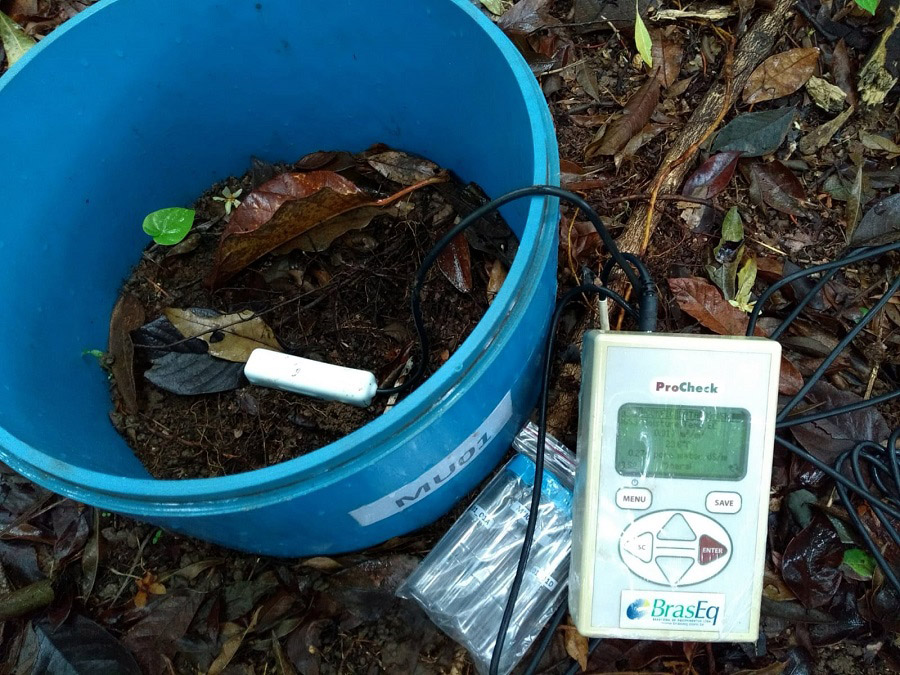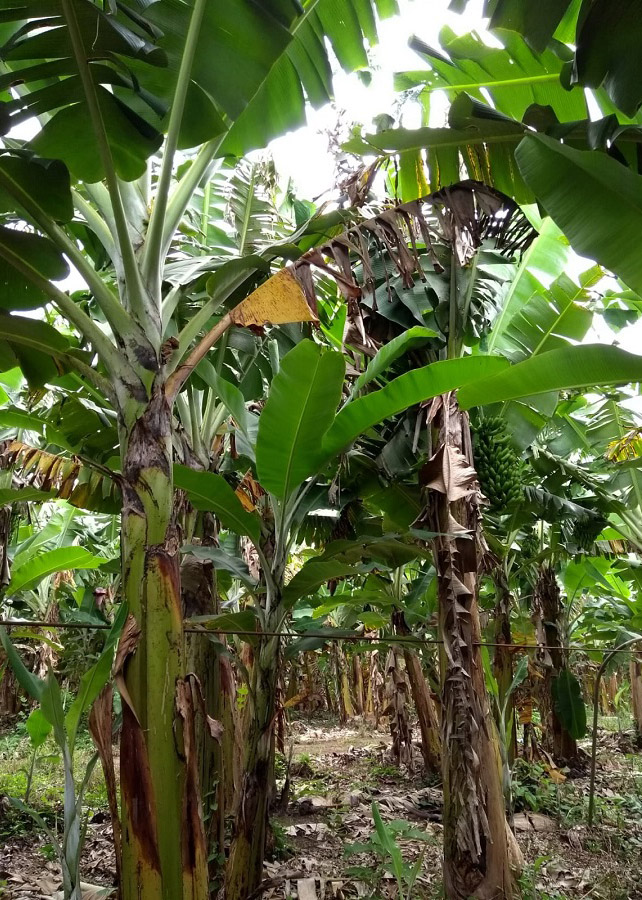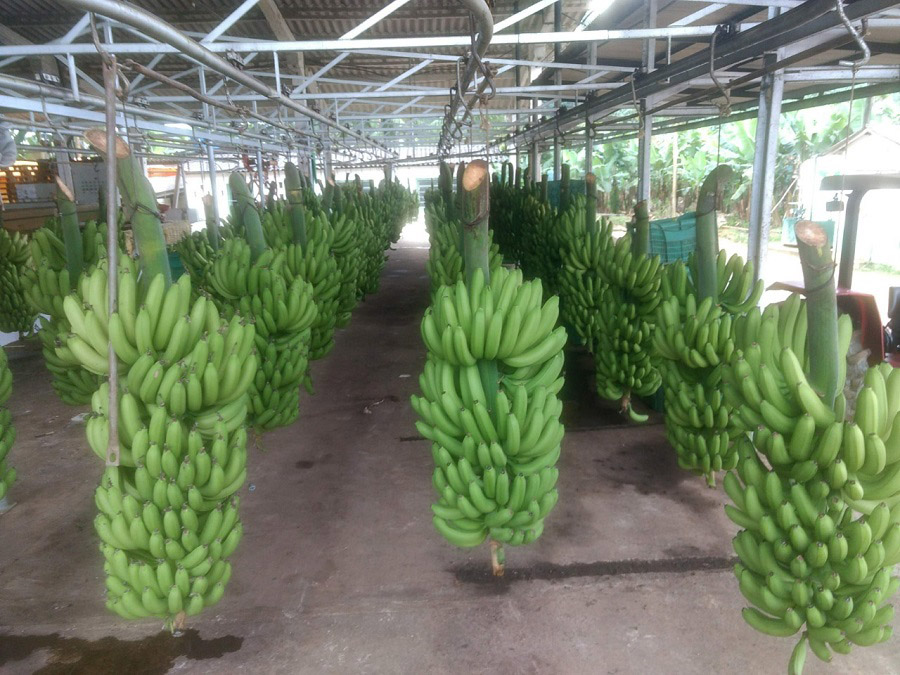Young banana plantations have lower ability to absorb methane from the soil when compared to forest remnants. The collected data can inform national and international greenhouse gas inventories. There are still few studies on greenhouse gas emissions in tropical orchards despite the emission potential of such crops. The research was conducted in Registro, SP, by Unesp, UFSCar and Embrapa. Age and management practices are factors that influenced the greenhouse gas emissions in banana grove soils. The discovery results from a study developed by scientists from the São Paulo State University (Unesp), the Federal University of São Carlos (UFSCar) and Embrapa Environment (SP) published in the paper CO2, CH4 and N2O emissions after fertilizer application in banana plantations located in the Brazilian Atlantic Forest. The work was initiated in 2018 in the city of Registro, an Atlantic rainforest region in the Brazilian state of São Paulo, and aimed to discover whether greenhouse gas emissions in a conventional banana management system would be higher than those in remnant forest fragment soils. The researchers found that plantations show higher nitrous oxide emissions and lower methane uptake capacity than the forest remnants. They also proved that the extension of these effects is influenced by the age of the banana grove, the addition of nitrogen fertilizers, and the season of the year. "This discovery, in the conditions where the studies were led, has been reported for the first time", asserts the professor responsible at Unesp, Reginaldo Barboza. “Current management practices adopted in banana plantations can result in negative impacts on environmental sustainability, especially in the Vale do Ribeira region, which has the last untouched areas of the Atlantic Rainforest biome. Consequently, we stress that the adoption of conservationist practices is extremely important. Such data can inform national inventories of anthropogenic greenhouse gas emissions and removals in tropical regions that are usually part of international reports”, he underscores. Many studies have demonstrated that conventional soil management has effects on greenhouse gas (GHG) emissions for several economically important crops. However, there is little research concerning areas with conventional tropical fruits. "There is lack of greenhouse gas measurements from fruit orchards, which can result in biases in the global emissions estimates if they are not based on representative measurements. Bananas fit in this category, and even though a lot is known about the plant's physiology, nutritional requirements, better cultivars and integrated pest and disease management, little is known about the environmental impacts of conventional banana cropping", states the Embrapa researcher Paula Packer. The data have shown that young plantations can have strongly reduced soil methane uptake capacity in comparison with forest remnants, while established plantations partly recover such ability", Packer reports.(see box below) The treatments that received ammonium sulphate and urea as a source of fertilization, in different stages of the plantation, showed changes in their soil emissions of carbon dioxide, methane and nitrogen, and lower methane uptake potential was observed in the young and the established banana plantations than in the forest remnants. Nitrous oxide emissions were higher in the young and in the established banana plantations than in the forest remnants. The study also verified that, during the rainy season, the young banana grove soils that are fertilized with urea can emit more greenhouse gases. Age of the plantation and GHG emissions The age of the banana plantation seems to be an important factor in the annual balance of GHG emissions. The effects of nitrogen inputs and environmental conditions (i.e. soil and air temperature, direct radiation and soil water availability) to increase the net GHG flux are reduced with age More recent soil tillage in young banana plantations was the factor leading to the highest GHG emissions When young banana plantation soils are tilled, the aggregates are exposed and microorganism activity is promoted, which facilitates the mineralization of organic matter and consequently increases carbon and nitrogen emissions and decreases carbon accumulation. More diverse, abundant and stable soil ecological niches, combined with the full physiological maturity of the plant, result in a better use of the nitrogen and reduce the effects of environmental factors (i.e. soil and air temperature, direct radiation and soil water availability). In the soils of established banana plantations, there is an organic matter layer formed from the leaves and shoots that are cut during the management, forming an undergrowth, which affects the physical, chemical and biologicalparameters of the soil. The formation of this layer promotse microbial activity and thus carbon and nitrogen immobilization, reducing gas fluxes into the atmosphere in established plantations in comparison with young banana plantations. By evaluating the resulting annual methane emissions in fertilized and unfertilized treatments to forest remnants, to young plantations and to established banana plantations, it is possible to infer that the reduced ammonium and methane oxidation rates were higher due to different land uses (fruit or forest) than due to fertilization alone. Banana management In banana cultivation, the conventional management of the soil surface includes ploughing and harrowing to approximately 30-cm depths, where most of the banana tree roots are concentrated. Young and well-established banana plantations present different management arrangements at different stages of plant development and soil conditions. After the first soil tillage, when the plants are still young, the soil of the banana plantation remains bare. Then, until the orchard is reformed, there is machine traffic and human trampling. The management of mature banana trees includes the removal of leaves, shoots, and other plant materials that are left to decompose over the soil and tend to accumulate over time. Despite being semi perennial, banana plantations are annually fertilized with excessive inorganic fertilizer rates, which can be performed up to 13 times a year. There are frequent applications of agrochemicals, which include fungicides, nematicides and occasionally herbicides, in addition to annual liming. Recommendations As expected, the experiment has shown that remnant forests have lower nitrous oxide emissions and higher net soil methane uptake. The net GHG flux (emission or consumption) stems from the interaction between management and environmental conditions in the banana plantation scenarios. The time when the fertilizer was applied, that is, the rainy season, had a greater influence on the flux dynamics and annual emissions than the fertilizer composition. Given the negative environmental effect of nitrous oxide emissions, reducing nitrogen applications and the adoption of conservation practices are fundamental for banana crops, especially in young plantations. The researchers recall that conservation practices such as integrated management, intercropped cultivation systems and agroforestry systems help to improve soil quality Increasing nitrogen use efficiency and avoiding conditions favourable to nitrous oxide emissions should also reduce gaseous nitrogen losses to the atmosphere. Once urea is the main nitrogen source used in banana plantations, the addition of urease and nitrification inhibitors can reduce nitrous oxide emissions by 73% when compared to the use of conventional fertilizers. Moreover, ideal cultivation conditions of soil type, texture, slope and position in the landscape are important factors to be considered. Bananas in the world Banana is the most traded tropical fruit in the world and is the world's fifth most important agricultural crop. In the world, the harvested area covers over 5 million hectares, and India, China, Brazil and Equator are the world's top producing countries. São Paulo is the largest banana producing state of Brazil, with an average production of 20 tons per hectare. The Vale do Ribeira region accounts for 67.9% of all the bananas cultivated in the state of São Paulo, reaching yield of 26 tons per hectare. This region is one of the last and largest areas with native Atlantic Rainforest vegetation or remnants. This bioma has a large abundance of plant and animal species, which classifies it as one of most important hotspots for biodiversity conservation. "We have selected a remnant forest fragment because it is one of the most common conditions found in this biome. The forest remnant where the collections were performed is at an advanced stage of regeneration and was used as a reference area to compare emissions in banana plantation soils", Silva explains.
Photo: Reginaldo Barboza (Unesp)
![Reginaldo Barboza (Unesp) - View of +30-year-old banana plantation and layout of gas-collecting chambers Reginaldo Barboza (Unesp) - View of +30-year-old banana plantation and layout of gas-collecting chambers]()
View of +30-year-old banana plantation and layout of gas-collecting chambers
Age and management practices are factors that influenced the greenhouse gas emissions in banana grove soils. The discovery results from a study developed by scientists from the São Paulo State University (Unesp), the Federal University of São Carlos (UFSCar) and Embrapa Environment (SP) published in the paper CO2, CH4 and N2O emissions after fertilizer application in banana plantations located in the Brazilian Atlantic Forest.
 The work was initiated in 2018 in the city of Registro, an Atlantic rainforest region in the Brazilian state of São Paulo, and aimed to discover whether greenhouse gas emissions in a conventional banana management system would be higher than those in remnant forest fragment soils. The researchers found that plantations show higher nitrous oxide emissions and lower methane uptake capacity than the forest remnants. They also proved that the extension of these effects is influenced by the age of the banana grove, the addition of nitrogen fertilizers, and the season of the year.
The work was initiated in 2018 in the city of Registro, an Atlantic rainforest region in the Brazilian state of São Paulo, and aimed to discover whether greenhouse gas emissions in a conventional banana management system would be higher than those in remnant forest fragment soils. The researchers found that plantations show higher nitrous oxide emissions and lower methane uptake capacity than the forest remnants. They also proved that the extension of these effects is influenced by the age of the banana grove, the addition of nitrogen fertilizers, and the season of the year.
"This discovery, in the conditions where the studies were led, has been reported for the first time", asserts the professor responsible at Unesp, Reginaldo Barboza. “Current management practices adopted in banana plantations can result in negative impacts on environmental sustainability, especially in the Vale do Ribeira region, which has the last untouched areas of the Atlantic Rainforest biome. Consequently, we stress that the adoption of conservationist practices is extremely important. Such data can inform national inventories of anthropogenic greenhouse gas emissions and removals in tropical regions that are usually part of international reports”, he underscores.
Many studies have demonstrated that conventional soil management has effects on greenhouse gas (GHG) emissions for several economically important crops. However, there is little research concerning areas with conventional tropical fruits.
"There is lack of greenhouse gas measurements from fruit orchards, which can result in biases in the global emissions estimates if they are not based on representative measurements. Bananas fit in this category, and even though a lot is known about the plant's physiology, nutritional requirements, better cultivars and integrated pest and disease management, little is known about the environmental impacts of conventional banana cropping", states the Embrapa researcher Paula Packer.
The data have shown that young plantations can have strongly reduced soil methane uptake capacity in comparison with forest remnants, while established plantations partly recover such ability", Packer reports.(see box below)
The treatments that received ammonium sulphate and urea as a source of fertilization, in different stages of the plantation, showed changes in their soil emissions of carbon dioxide, methane and nitrogen, and lower methane uptake potential was observed in the young and the established banana plantations than in the forest remnants. Nitrous oxide emissions were higher in the young and in the established banana plantations than in the forest remnants. The study also verified that, during the rainy season, the young banana grove soils that are fertilized with urea can emit more greenhouse gases.
 Age of the plantation and GHG emissions Age of the plantation and GHG emissions
The age of the banana plantation seems to be an important factor in the annual balance of GHG emissions. The effects of nitrogen inputs and environmental conditions (i.e. soil and air temperature, direct radiation and soil water availability) to increase the net GHG flux are reduced with age More recent soil tillage in young banana plantations was the factor leading to the highest GHG emissions When young banana plantation soils are tilled, the aggregates are exposed and microorganism activity is promoted, which facilitates the mineralization of organic matter and consequently increases carbon and nitrogen emissions and decreases carbon accumulation. More diverse, abundant and stable soil ecological niches, combined with the full physiological maturity of the plant, result in a better use of the nitrogen and reduce the effects of environmental factors (i.e. soil and air temperature, direct radiation and soil water availability). In the soils of established banana plantations, there is an organic matter layer formed from the leaves and shoots that are cut during the management, forming an undergrowth, which affects the physical, chemical and biologicalparameters of the soil. The formation of this layer promotse microbial activity and thus carbon and nitrogen immobilization, reducing gas fluxes into the atmosphere in established plantations in comparison with young banana plantations. By evaluating the resulting annual methane emissions in fertilized and unfertilized treatments to forest remnants, to young plantations and to established banana plantations, it is possible to infer that the reduced ammonium and methane oxidation rates were higher due to different land uses (fruit or forest) than due to fertilization alone. |
Banana management In banana cultivation, the conventional management of the soil surface includes ploughing and harrowing to approximately 30-cm depths, where most of the banana tree roots are concentrated. Young and well-established banana plantations present different management arrangements at different stages of plant development and soil conditions. After the first soil tillage, when the plants are still young, the soil of the banana plantation remains bare. Then, until the orchard is reformed, there is machine traffic and human trampling. The management of mature banana trees includes the removal of leaves, shoots, and other plant materials that are left to decompose over the soil and tend to accumulate over time. Despite being semi perennial, banana plantations are annually fertilized with excessive inorganic fertilizer rates, which can be performed up to 13 times a year. There are frequent applications of agrochemicals, which include fungicides, nematicides and occasionally herbicides, in addition to annual liming. |
 Recommendations
Recommendations
As expected, the experiment has shown that remnant forests have lower nitrous oxide emissions and higher net soil methane uptake. The net GHG flux (emission or consumption) stems from the interaction between management and environmental conditions in the banana plantation scenarios. The time when the fertilizer was applied, that is, the rainy season, had a greater influence on the flux dynamics and annual emissions than the fertilizer composition.
Given the negative environmental effect of nitrous oxide emissions, reducing nitrogen applications and the adoption of conservation practices are fundamental for banana crops, especially in young plantations.
The researchers recall that conservation practices such as integrated management, intercropped cultivation systems and agroforestry systems help to improve soil quality Increasing nitrogen use efficiency and avoiding conditions favourable to nitrous oxide emissions should also reduce gaseous nitrogen losses to the atmosphere.
Once urea is the main nitrogen source used in banana plantations, the addition of urease and nitrification inhibitors can reduce nitrous oxide emissions by 73% when compared to the use of conventional fertilizers. Moreover, ideal cultivation conditions of soil type, texture, slope and position in the landscape are important factors to be considered.
 Bananas in the world Bananas in the world
Banana is the most traded tropical fruit in the world and is the world's fifth most important agricultural crop. In the world, the harvested area covers over 5 million hectares, and India, China, Brazil and Equator are the world's top producing countries. São Paulo is the largest banana producing state of Brazil, with an average production of 20 tons per hectare. The Vale do Ribeira region accounts for 67.9% of all the bananas cultivated in the state of São Paulo, reaching yield of 26 tons per hectare. This region is one of the last and largest areas with native Atlantic Rainforest vegetation or remnants. This bioma has a large abundance of plant and animal species, which classifies it as one of most important hotspots for biodiversity conservation. "We have selected a remnant forest fragment because it is one of the most common conditions found in this biome. The forest remnant where the collections were performed is at an advanced stage of regeneration and was used as a reference area to compare emissions in banana plantation soils", Silva explains. |
Cristina Tordin (MTb 28.499/SP)
Embrapa Environment
Press inquiries
Phone number: (19) 3311 2608
Translation: Mariana Medeiros (13044/DF)
General Secretariat
Further information on the topic
Citizen Attention Service (SAC)
www.embrapa.br/contact-us/sac/

 The work was initiated in 2018 in the city of Registro, an Atlantic rainforest region in the Brazilian state of São Paulo, and aimed to discover whether greenhouse gas emissions in a conventional banana management system would be higher than those in remnant forest fragment soils. The researchers found that plantations show higher nitrous oxide emissions and lower methane uptake capacity than the forest remnants. They also proved that the extension of these effects is influenced by the age of the banana grove, the addition of nitrogen fertilizers, and the season of the year.
The work was initiated in 2018 in the city of Registro, an Atlantic rainforest region in the Brazilian state of São Paulo, and aimed to discover whether greenhouse gas emissions in a conventional banana management system would be higher than those in remnant forest fragment soils. The researchers found that plantations show higher nitrous oxide emissions and lower methane uptake capacity than the forest remnants. They also proved that the extension of these effects is influenced by the age of the banana grove, the addition of nitrogen fertilizers, and the season of the year.


